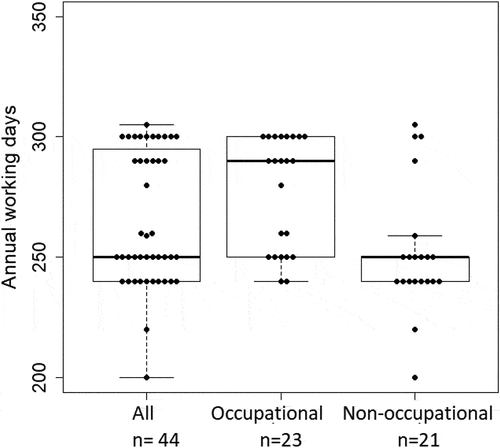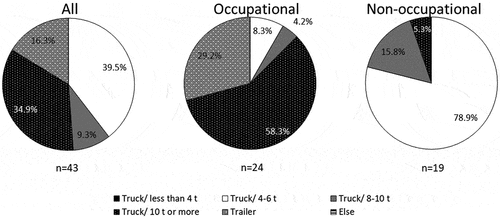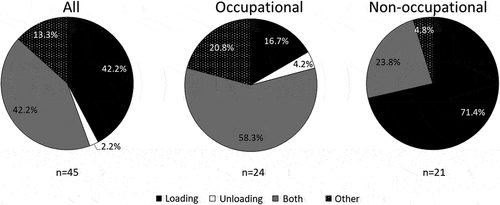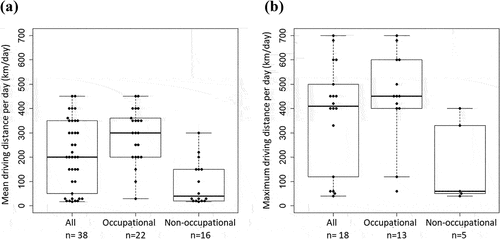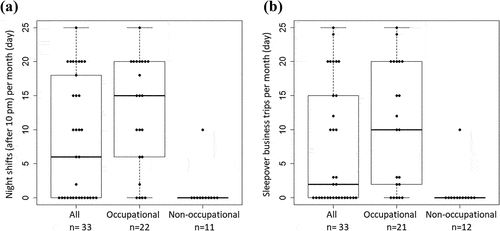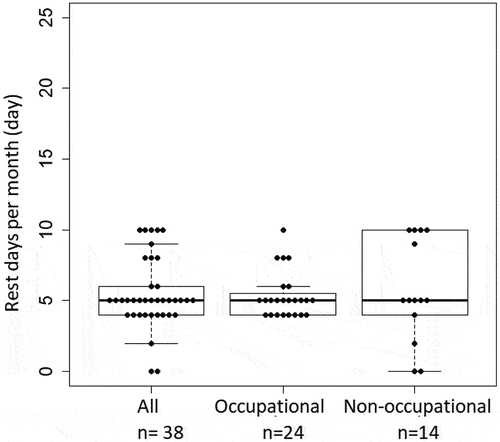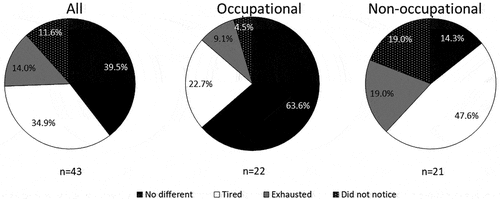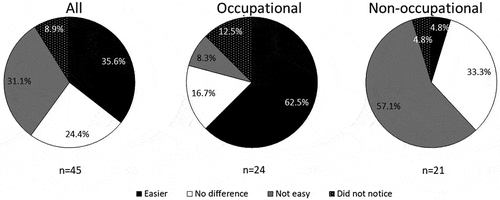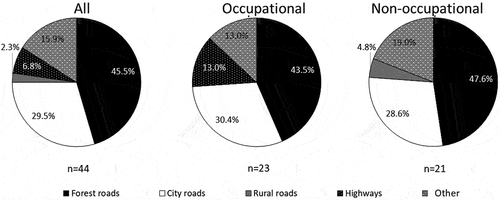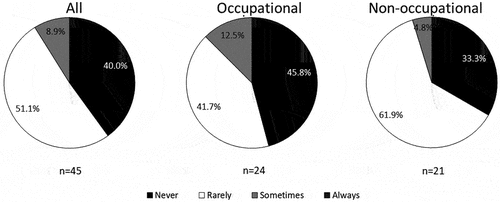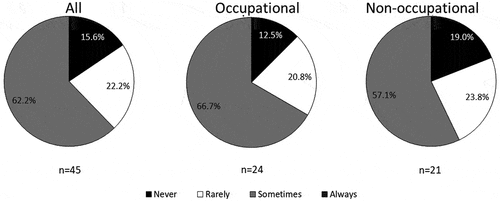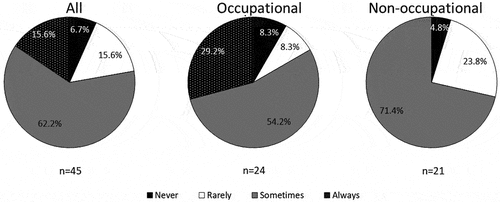ABSTRACT
This study clarified the working conditions and fatigue in log truck drivers in Japan’s forestry industry. Log truck drivers in Mie Prefecture, central Japan, were surveyed by questionnaires and interviews. In total, 45 valid responses were obtained from drivers; 24 who worked for transportation firms were defined as “occupational drivers” and 21 who worked for forestry cooperatives or logging companies were defined as “non-occupational drivers.” Many of the responses implied that occupational drivers had poor working conditions, making them prone to fatigue. The average mean driving distance per day of occupational drivers was about three times that of non-occupational drivers. One occupational driver reported a maximum driving distance of 700 km/day. The average mean driving time per day of occupational drivers was about two times that of non-occupational drivers. One occupational driver reported a maximum driving time of 18 h/day. However, many of the answers indicated that non-occupational drivers felt more fatigue; 66.6% had felt tired or exhausted compared to 31.8% of occupational drivers. Two-thirds of occupational drivers answered that log transportation was easier than other transportation driving compared to 4.8% of non-occupational drivers. Many non-occupational drivers (57.1%) felt that log transportation was not easy. It was not a daily task for them, as they usually drove only after logging. The non-occupational drivers felt more nervous driving relatively large trucks and transporting logs compared to the occupational drivers. These results can help inform management in the forestry industry and will contribute to improving drivers’ working environment and reducing fatigue.
Introduction
Generally, truck drivers find their working environment difficult due to long working hours, stressful driving conditions, and the risk of road accidents (Baas et al. Citation2000; Torregroza-Vargas et al. Citation2014; Mahachandra and Sutalaksana Citation2015; National Academies of Sciences Citation2016; Wunderlich et al. Citation2020). In the United States, approximately 4000 fatalities due to truck and bus accidents occur each year, and up to 20% are estimated to involve fatigued drivers (National Academies of Sciences Citation2016). In New Zealand, many drivers exceed the legal limit of 11 h of driving and 14 h on duty by undertaking multiple trips a day (Baas et al. Citation2000). In Indonesia, fuel-truck drivers sometimes exceed the regulation driving time of 12 h due to traffic congestion in urban areas, and they may take only a 6 h break before driving again (Mahachandra and Sutalaksana Citation2015). Thus, truck drivers work under stressful conditions with long driving hours, poor work schedules, and inadequate rest. Many studies have described working conditions and noted that risks to drivers in the trucking industry need to be decreased (Gander et al. Citation2006; Kee et al. Citation2010; Oyama et al. Citation2011).
Similarly, drivers who transport logs work under difficult conditions, such as on poor roads and in steep terrain. Although log transportation is an essential component of the wood supply chain, it is very stressful because drivers have to transport long heavy logs from harvest sites or lumber yards to processing facilities under difficult conditions. Additionally, the weight distribution of log trucks can differ from other cargo types (Cole et al. Citation2019). In the United States, fatal log truck accidents increased by 41% nationwide between 2011 and 2015 compared to 16% for all large vehicles (Cole et al. Citation2019). In addition, log trucks have a higher risk of rollover than other vehicles, as large, older vehicles are often used for log transportation. According to research based on the Fatality Analysis Reporting System database, most log truck accidents consist of tractor-trailer configurations (84%), and old vehicles with an average age of 13 years are used for log transportation in the United States (Cole et al. Citation2019). In response to recent weight restrictions on interstate roads in the US South, it has been suggested that interstate routes can enable safer timber transportation (Conrad Citation2020), but regulations have increased accidents (Conrad Citation2021). Moreover, to transport felled wood to sawmills, log-transport trucks drive on many types of road, including gravel roads, local roads, provincial roads, and highways (Greene et al. Citation2007). Therefore, log transportation may be more tiring and entail a higher risk of accidents compared to other transportation.
Since log truck drivers have various affiliations, their working environments are poorly understood in Japan. The working environment of drivers in the trucking industry has long been a major problem (Nagashima and Kaneko Citation1992; Oyama et al. Citation2011). Rollover and tipping over of trucks at bends on forest roads have been reported as causes of fatal accidents. Accidents caused by logs or timber slipping from the truck bed or the collapse of stacked logs or timber have occurred even when not in motion in Japan (Forestry and Timber Manufacturing Safety and Health Association Citation2021). However, few studies have focused on the working environment of drivers who transport logs from harvest sites or wood markets to processing facilities, although many fatal accidents and injuries have occurred. According to a report on industrial accidents involving forestry workers in Japan, between 2000 and 2020, 38 fatal accidents occurred during log transportation and related tasks such as loading and unloading.
An unhealthy working environment and driver fatigue can lead to accidents. Several studies have investigated driver fatigue when driving on forest roads from an ergonomic perspective. For instance, truck drivers’ physiological burden has been evaluated based on the structural details of a forest road such as bends (Iwakawa et al. Citation1989) and sight distances (Pan et al. Citation1998). Our previous study reported that most truck drivers had experienced near accidents, and 70% had experienced more than three near accidents during the previous 3 years (Nakata et al. Citation2021). However, most studies related to working conditions and fatigue have focused on the risks associated with forest harvesting, such as tree felling and skidding (e.g., Iwakawa et al. Citation1989; Pan et al. Citation1998; Uemura et al. Citation2010; Kashima et al. Citation2014). Drivers who transport logs in Japan are generally divided into drivers whose main job is to transport logs or timber and drivers who also perform forestry operations such as silviculture and harvesting. The former often work for transportation companies while the latter often work for forestry cooperatives. Given that the working conditions and fatigue of log-truck drivers may differ from those of other drivers due to the difference in time spent driving, methods for improving their working conditions may also differ.
The purpose of this research was to clarify the working conditions and fatigue among log truck drivers in Japan’s forestry industry. To this end, log truck drivers were surveyed using questionnaires and interviews. We expected that the working conditions and levels of fatigue of drivers working in forestry would differ depending on their affiliation as occupational drivers or non-occupational drivers.
Materials and methods
Study site
Our study was conducted in Mie Prefecture, central Japan (), where forest covers 372,352 ha, accounting for 64% of the prefecture’s area. Of the forests, 62% are planted forests, 70% of which are more than 50 years old and suitable for harvesting. The annual log production of Mie Prefecture is 300,000 m3, of which 60% is used for sawtimber (Mie Prefecture Citation2021). The region is a major timber producing area of Japan, ranking second in Japan in the number of sawtimber mills (sawmills, lumber mills). The prefecture is famous for its production of Japanese cypress (Chamaecyparis obtusa). The Owase region, in southern Mie Prefecture, produces Owase Hinoki (C. obtusa). It is adjacent to Yoshino in the Nara Prefecture, which is known for the production of Japanese cedar (Cryptomeria japonica). Given these rich production areas, this area is a logistical hub for the production and transport of these species. Therefore, drivers frequently travel between those prefectures. However, we focus here only on those based in Mie Prefecture. shows examples of trucks and truck/trailer combinations typically used in Japan. Although forestry used to be one of the prefecture’s major industries, similar to other parts of Japan, the industry has experienced a recession since the liberalization of timber imports began in 1964. However, the number of biomass power plants in Japan, including in Mie Prefecture, has been rapidly increasing because of the introduction of the feed-in tariff in 2012. Therefore, timber transportation is expected to increase as a result of the growing demand for fuel wood by woody biomass power plants over and above sawed wood production, in addition to the usual supply of building materials.
Figure 2. The truck and truck/trailer combinations typically used in Japan (photographs by Y Chinone). A truck (ISUZU) with a maximum load capacity of 3.5 t (A), a truck (Mitsubishi Fuso) with a maximum load capacity of 6 t with a grapple loader (B), a truck (ISUZU) with a maximum load capacity of 10 t (C), and a truck/trailer combination (HINO) with a maximum load capacity of 20 t (D).
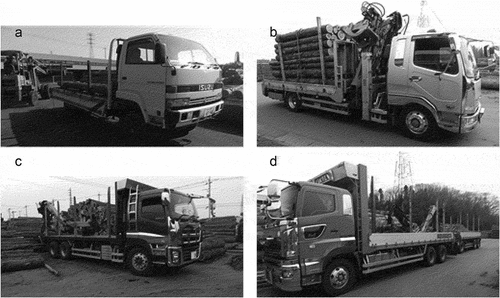
Methods
After first explaining to the subjects how the data would be handled, questionnaire and interview surveys were conducted between September 2018 and February 2019 to ask about the working environment and fatigue of log truck drivers in the forestry industry in Mie Prefecture. The contents of the interview and questionnaire were the same. We interviewed and handed out questionnaires to drivers belonging to a forestry cooperative and to transport firms that visited two roundwood auction markets. We also gave questionnaires to two logging companies through one forestry cooperative and one roundwood auction market. The forestry cooperative is made up forest owners who manage forests in the region. The cooperative and roundwood auction market are of average size. Many shippers and buyers from neighboring prefectures gather in the markets surveyed, which is a typical situation. Therefore, we should be able to collect appropriate samples to survey the typical working conditions of log truck drivers in Japan. Although the head offices of two transportation firms were not located in Mie Prefecture, they were responsible for transportation to and from Mie Prefecture. The questionnaire and interview questions were constructed based on previous research on accidents and fatigue among forestry workers (Sakai and Tohachi Citation2008) and truck drivers in other industries (Nagashima and Kaneko Citation1992; Adams-Guppy and Guppy Citation2003; Oyama et al. Citation2011).
From the questionnaires and interviews, we obtained general demographic information about the respondents, including gender, age, and years of truck/trailer driving experience. Regarding working conditions, we asked about annual working days, the maximum capacity of the trucks or trailers they drove, main job, work of loading and unloading associated with log transportation, driving distance and time, days of night shifts or sleepover business trips, and rest days. Regarding driver fatigue, we obtained information on fatigue due to driving relatively large trucks, difficulty in log transportation, roads on which drivers felt nervous, ill at ease, or drowsy, took time to rest or nap, and had difficulty in finding places to park. Drivers were classified as occupational drivers or non-occupational drivers based on their work affiliation. Drivers belonging to transportation firms were defined as “occupational drivers” and drivers belonging to forestry cooperatives or logging companies were defined as “non-occupational drivers.”
Working conditions and fatigue were compared between the two groups using R v3.6.2. The means of the two groups were compared using t-tests. For numerical data, Student’s t-tests and Welch’s two-sample tests were used. For categorical data, the χ2 test and residual analysis was used to clarify the items with large residuals.
Results
General information on the respondents
Forty-nine responses from the questionnaires and interviews were received from log truck drivers, of which 45 were considered valid. We excluded four responses from our analysis because of deficiencies; the respondents did not answer the questions regarding work situation and health conditions. Some of the 45 valid respondents also did not answer all questions. Respondents were divided into two groups based on their work affiliation: 24 worked for transportation firms and were defined as “occupational drivers” and 21 worked for forestry cooperatives or logging companies and were defined as “non-occupational drivers.”
All respondents were men; the mean ages of the occupational and non-occupational drivers were 49.4 ± 10.86 and 43.9 ± 9.28 years (mean ± SD), respectively. Although occupational drivers were older, there was no significant difference in age between the two groups (, p > 0.05, t-test). The mean years of truck-driving experience of the occupational drivers and non-occupational drivers were 23.5 ± 10.27 and 15.3 ± 11.33, respectively (). The mean years of log truck driving experience of occupational drivers and non-occupational drivers were 21.5 ± 11.36 and 11.0 ± 8.89, respectively (). Occupational drivers had significantly more driving experience than non-occupational drivers (p < 0.01, t-test).
Working conditions
Occupational drivers worked significantly more days annually than did non-occupational drivers (277.4 ± 23.40 vs. 252.1 ± 26.28; p < 0.01, t-test; ). The types of trucks driven differed significantly between the two affiliations (p < 0.001, χ2 [2 × 6] test; ); occupational drivers drove trucks larger than 10 tons (58.3%) or trailers (29.2%), whereas most non-occupational drivers (78.9%) drove 4- to 6-ton trucks. Residual analysis revealed that occupational drivers drove trucks greater than 10 tons significantly more often than non-occupational drivers, and non-occupational drivers drove 4- to 6-ton trucks significantly more than did occupational drivers.
The main jobs of drivers differed significantly between the two groups (p < 0.001, χ2 [2 × 6]; ), with occupational drivers primarily engaged in log transportation (91.7%) and non-occupational drivers engaged in felling and logging using chainsaws, operating forestry machinery, and other work (60%). Residual analysis revealed that occupational drivers engaged in log transportation significantly more often than did non-occupational drivers, and non-occupational drivers engaged in Other work such as cutting and planting significantly more often than occupational drivers. Moreover, drivers occasionally performed loading and unloading as tasks associated with timber transportation; 16.7% and 71.4% of occupational and non-occupational drivers performed only loading, 4.2% and 0% of occupational and non-occupational drivers performed only unloading, and 58.3% and 23.8% of occupational and non-occupational drivers performed both tasks, respectively. There was a significant difference between the two affiliations in log loading and unloading work done by drivers (p < 0.01, χ2 [2 × 4]; ). Residual analysis revealed that occupational drivers performed unloading work significantly more often than did non-occupational drivers, although non-occupational drivers performed both loading and unloading work significantly more often than did occupational drivers.
Figure 7. Main job with which drivers were engaged at their company. Multiple answers are included in other.
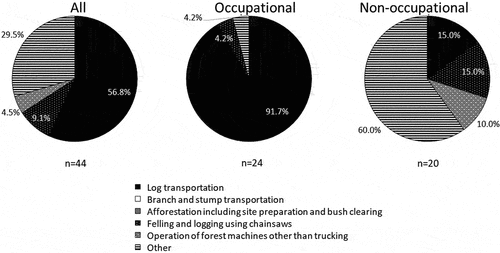
Occupational drivers drove more than three times the mean distance per day as compared to non-occupational drivers (288.2 ± 112.53 vs. 94.2 ± 89.80 km/day; p < 0.001, t-test; ). The average maximum driving distance per day of occupational drivers (448.5 ± 189.25 km/day) was longer than that of non-occupational drivers (176.0 ± 174.44 km/day; p < 0.05, t-test; ). One occupational driver reported a maximum driving distance of 700 km/day. Moreover, occupational drivers spent about twice as long per day driving compared to non-occupational drivers (8.6 ± 3.12 h/day vs. 4.0 h ± 2.87 h/day; p < 0.001, t-test; ). The average maximum driving time per day of occupational drivers (10.7 ± 4.20 h/day) was longer than that of non-occupational drivers (4.5 ± 2.84; p < 0.01 t-test; ). One occupational driver reported a maximum driving time of 18 h/day.
Compared to non-occupational drivers, occupational drivers reported significantly more days with night shifts after 10 pm (0.9 ± 3.02 days/month vs. 12.4 ± 8.27 days/month; p < 0.001, Welch’s test) and sleepover business trips (0.8 ± 2.89 vs. 10.5 ± 9.21 days/month; p < 0.001, Welch’s test; ). However, the mean numbers of rest days per month did not differ significantly (p > 0.05, t-test) between the non-occupational (5.3 ± 1.61 days/month) and occupational (5.7 ± 3.60 days/month) drivers ().
Driver fatigue
presents the level of fatigue due to driving larger trucks. Although 63.6% of the occupational drivers had no difference in fatigue after driving relatively large trucks, 66.6% of non-occupational drivers felt tired or exhausted after driving them. There was a significant difference between the two affiliations (p < 0.05, χ2 (2 × 4) test), while residual analysis revealed that occupational drivers felt no different significantly more often than did non-occupational drivers.
shows the degree of difficulty transporting logs compared to other cargo. Two thirds of occupational drivers (62.5%) answered that log transportation was easier than transporting other cargo, compared to 4.8% of non-occupational drivers. Many non-occupational drivers (57.1%) felt that log transportation was not easy. There was a significant difference between the two affiliations (p < 0.001, χ2 [2 × 4] test). Residual analysis revealed that significantly more occupational drivers than non-occupational drivers felt log transportation was easier.
shows roads on which drivers felt nervous transporting logs. Many of the drivers felt nervous when driving on forest roads, and there was no significant difference between the two affiliations (p > 0.05, χ2 [2 × 5] test).
reports the experience of feeling ill at ease while driving. More than 90% of all drivers said that they never or rarely felt uncomfortable while driving, with no significant difference between the two affiliations (p > 0.05, χ2 [2 × 4] test).
Regarding the frequency of driving while drowsy (), more than half of the drivers in both groups (66.7% of occupational drivers and 57.1% of non-occupational drivers) had sometimes driven while drowsy. There was no significant difference between the two affiliations (p > 0.05, χ2 [2 × 4] test).
Many occupational (87.5%) and non-occupational (85.8%) drivers felt they had enough or nearly enough rest when they were not driving (), with no significant difference between the two affiliations (p > 0.05, χ2 [2 × 4] test).
Many occupational (83.4%) and non-occupational (71.4%) drivers sometimes or always had trouble finding parking to wait or rest (), with a significant difference between the two affiliations (p < 0.05, χ2 [2 × 4] test). Residual analysis revealed that significantly more occupational drivers than non-occupational drivers always had difficulty parking.
Discussion
This study evaluated working conditions and fatigue in log truck drivers in Japan’s forestry industries using questionnaires and interviews. We expected that drivers’ working conditions and fatigue levels would differ depending on their work affiliations, and we found some differences between occupational drivers and non-occupational drivers.
General information on the respondents
The occupational drivers were slightly older than the non-occupational drivers, and had more experience transporting logs than the non-occupational drivers. A labor-force survey reported that Japan has a relatively low proportion of young truck drivers and a relatively high proportion of elderly drivers (Ministry of Internal Affairs and Communications Citation2021). In the forestry industry in Japan, the average age of forestry workers is increasing. In Mie Prefecture, more than 30% of all forestry workers are over the age of 60 (Mie Prefecture Citation2021). Because fatigue and the risk posed by driving can increase with age-related health problems and illnesses such as hypertension and obesity (Sieber et al. Citation2014), even with sufficient driving experience, improvements in working conditions are urgently needed in log transportation.
Working conditions
Many of the answers revealed that occupational drivers experienced poor working environments, making them prone to fatigue. Although occupational drivers may drive longer distances from the roundwood auction market to processing facilities such as sawmills on public roads and highways, non-occupational drivers may drive shorter distances from the harvest site to the roundwood auction market on forest roads. Forest roads are built to different standards and have different operating conditions from those commonly traveled by other cargo body types, such as speeds, driving effort, curves, steep slopes, loose surfaces, and narrow widths. Such conditions may be more stressful for the driver than driving long distances. Such a difference in the range of activities may influence their energy levels.
Driving distance and time both affect fatigue (Gander et al. Citation2006; Kee et al. Citation2010; Oyama et al. Citation2011), as do the time and quality of rest (Oyama et al. Citation2011; Davidović et al. Citation2018); excessive driving and inadequate rest can both increase the possibility of fatal accidents (Mohamed et al. Citation2012). The risks of fatigue and accidents increase when driving time exceeds 12 h (Gander et al. Citation2006; Torregroza-Vargas et al. Citation2014); therefore, each country has driving time limits. The laws in Australia, Canada, Europe, and the United States limit the daily driving time for truck drivers to 9–13 h (Goel Citation2012; Goel et al. Citation2012; Goel and Rousseau Citation2012). In Japan, according to the standards set by the Ministry of Health, Labor and Welfare (Citation1989), truck drivers are generally limited to 13 h a day, although some situations allow up to 16 h; however, periods of driving exceeding 15 h are limited to twice a week. Although both occupational and non-occupational drivers drove within these limits, one occupational driver noted 18 h/day as being the maximum driving time per day. Another occupational driver reported a maximum driving distance of 700 km/day. In 2018, the Japanese Parliament enacted a labor reform law that aimed to drastically change the way people work; this will limit overtime hours in the transportation industry to 960 h/year as of 1 April 2024 (Ministry of Health, Labor and Welfare Citation2018). Although there is little overtime work in the timber transportation industry, it may be necessary to manage the driving hours of occupational drivers strictly using digital tachographs (Oyama et al. Citation2012) depending on the supply and demand of woody biomass plants installed in many parts of Japan. Mie Prefecture functions as a logistics hub for timber from the Owase region, in southern Mie Prefecture and Yoshino in neighboring Nara Prefecture. Many shippers and buyers from neighboring prefectures come to markets in Mie Prefecture. Therefore, because the transport process tends to be time-consuming, it is necessary to optimize collecting areas to minimize the transportation time.
Driver fatigue
The responses showed that non-occupational drivers generally experienced fatigue more often. This may have been because occupational drivers routinely tended to use relatively large vehicles to carry large amounts of material at once, whereas non-occupational drivers tended to use relatively small trucks.
Non-occupational drivers often performed work other than transportation, such as felling, logging, and operating forestry machinery. Log transportation was not a daily task for them, because they usually transported logs only after logging. This may have been why the non-occupational drivers felt more nervous driving larger trucks and transporting logs compared to the occupational drivers. Although it was not included in our survey items, forest work such as felling, logging, and operating forestry machinery in forests on steep terrain in Japan cause physical fatigue (e.g., Iwakawa et al. Citation1989; Imatomi Citation2003: Sakai and Tohachi Citation2008). We propose dividing the labor between forest work and transportation.
Although non-occupational drivers carry out various tasks, it may be worth adopting a better division of labor instead of having the same worker perform all tasks. To achieve this, it would be effective to build an information-sharing system to link the occupational and non-occupational drivers. Some countries have already introduced a management system for optimizing transport plans, such as StanForD in forestry. Such systems contribute to labor management using operating records (Forestry Research Institute of Sweden Citation2014). As an individualized approach, it would be effective to upgrade forest roads so that occupational drivers could reach deep into the mountains with heavy trucks and shorten the transportation section used by non-occupational drivers.
Both types of drivers had a challenge finding rest stops. Although they felt fatigued while driving, it was sometimes difficult to find parking places. It has been suggested that a lack of space for parking and taking a nap affects driver stress (Oyama et al. Citation2012). Although the respondents said they had enough time to rest or nap, large spaces are necessary to allow large log transport vehicles to park. Recently, ICT-based parking management systems are being put to practical use. This has the potential to build a system for log truck parking applying these technologies.
Conclusion
We clarified the working conditions and fatigue levels of log truck drivers in Japan’s forestry industries in Mie Prefecture, central Japan, using questionnaires and interviews. Our research found differences between occupational and non-occupational drivers. Occupational drivers experienced poor working environments such as longer distances and more time, making them prone to fatigue. Non-occupational drivers generally experienced fatigue more often because they also did forest work. After a day operating a chainsaw or skidder, they might be more tired than an occupational truck driver. We propose separating labor between forest work and transportation. Building an information sharing system to link the occupational and non-occupational drivers may enable non-occupational drivers to focus on forest operations other than transporting logs. In addition, it would be effective to upgrade forest roads so that occupational drivers could reach deep into the mountains with heavy trucks and shorten the transportation section used by non-occupational drivers. Moreover, to counter the lack of parking space for taking naps, an ICT-based parking management system for log trucks should be built. However, the effects of forest work on the fatigue of non-occupational drivers could not be clarified. We plan to conduct further research on this.
Acknowledgements
The authors thank all of the log truck drivers who took the time to participate in this study and the managers for their involvement and authorization to collect the data. Our deepest appreciation also goes to Prof. Ishikawa for his continuing support and encouragement
Disclosure statement
No potential conflict of interest was reported by the author(s).
References
- Adams-Guppy J, Guppy A. 2003. Truck driver fatigue risk assessment and management: a multinational survey. Ergonomics. 46(8):763–779. doi:10.1080/0014013021000056980.
- Baas PH, Charlton SG, Bastin GT. 2000. Survey of New Zealand truck driver fatigue and fitness for duty. Transp Res Part F Traffic Psychol Behav. 3(4):185–193. doi:10.1016/S1369-8478(01)00003-1.
- Cole NB, Barrett SM, Bolding MC, Aust WM. 2019. An analysis of fatal log truck crashes in the United States from 2011 through 2015. Int J For Eng. 30(2):121–131.
- Conrad IVJL. 2021. Log truck crashes before and after weight limit increases in North Carolina and Virginia, USA. Int J For Eng. 32(3):266–277.
- Conrad IVJL. 2020. Would weight parity on interstate highways improve safety and efficiency of timber transportation in the US South? Int J For Eng. 31(3):242–252.
- Davidović J, Pešić J, Antić B. 2018. Professional drivers’ fatigue as a problem of the modern era. Transp Res F-Traf. 55:199–209. doi:10.1016/j.trf.2018.03.010.
- Forestry and Timber Manufacturing Safety and Health Association. List of forestry work accidents. [accessed 2021 Jan 27]. http://www.rinsaibou.or.jp/cont03/03_frm.html. [In Japanese].
- Forestry Research Institute of Sweden. 2014. StanForD. [accessed 2021 Aug 20]. https://www.skogforsk.se/english/projects/stanford/.
- Gander PH, Marshall NS, James I, Le Quesne L. 2006. Investigating driver fatigue in truck crashes: trial of a systematic methodology. Transport Res F. 9(1):65–76. doi:10.1016/j.trf.2005.09.001.
- Goel A. 2012. The minimum duration truck driver scheduling problem. EURO J Transp Logist. 1(4):285–306. doi:10.1007/s13676-012-0014-9.
- Goel A, Archetti C, Savelsbergh M. 2012. Truck driver scheduling in Australia. Comput Oper Res. 39(5):1122–1132. doi:10.1016/j.cor.2011.05.021.
- Goel A, Rousseau LM. 2012. Truck driver scheduling in Canada. J Scheduling. 15(6):783–799.
- Greene WD, Baker SA, Lowrimore T. 2007. Analysis of log hauling vehicle accidents in the state of Georgia, USA, 1988–2004. Int J For Eng. 18(2):52–57.
- Imatomi Y. 2003. Risk-taking behavior analysis of felling operations. J For Eng Soc. 18(1):37–41. [In Japanese].
- Iwakawa O, Kondo K, Ohno K. 1989. Studies on the qualitative evaluation of forest road construction and design (IV): an effect of different curve constructions used for forest road on the physiological responses to drivers. Bull Fac Agric Shizuoka Uni. 39: 5–9. In Japanese with English summary.
- Kashima H, Tsuzuki N, Kanomata H, Kohroki K. 2014. The present management condition of protective clothing for hand-held chain saw. J For Eng Soc. 29(2):119–126. In Japanese with English summary.
- Kee S, Tamrin SBM, Goh Y. 2010. Driving fatigue and performance among occupational drivers in simulated prolonged driving. Glob J Health Sci. 2(1):167.
- Mahachandra M, Sutalaksana IZ. 2015. Fatigue evaluation of fuel truck drivers. Procedia Manuf. 4:352–358. doi:10.1016/j.promfg.2015.11.051.
- Mie Prefecture. 2021. 2019 Forest and forestry statistics book. [accessed 2021 Mar 3]. https://www.pref.mie.lg.jp/common/content/000933575.pdf. [In Japanese].
- Ministry of Health, Labour and Welfare. 1989. Standards for improving working hours of car drivers. [accessed 2020 Apr 26]. https://www.mhlw.go.jp/web/t_doc?dataId=73028500&dataType=0&pageNo=1. [In Japanese].
- Ministry of Health, Labour and Welfare. 2018. For the realization of labor reform law. [accessed 2020 Apr 27]. https://www.mhlw.go.jp/stf/seisakunitsuite/bunya/0000148322.html. [In Japanese].
- Ministry of Internal Affairs and Communications. 2021. The labour force survey. [accessed 2021 Mar 22]. https://www.e-stat.go.jp/stat-search/files?page=1&layout=dataset&toukei=00200531&bunya_l=03&tstat=000000110001&stat_infid=000032060220&result_page=1. [In Japanese].
- Mohamed N, Mohd-Yusoff M, Othman I, Zulkipli Z, Osman M, Voon W. 2012. Fatigue-related crashes involving express buses in Malaysia: will the proposed policy of banning the early-hour operation reduce fatigue-related crashes and benefit overall road safety? Accident Anal Prev. 45:45–49. doi:10.1016/j.aap.2011.09.025.
- Nagashima K, Kaneko Y. 1992. Problems of land transportation company: job and job consciousness of truck driver. Depart Bull Paper. 20: 1–54. In Japanese.
- Nakata C, Itaya A, Yoshida C, Nakazawa M. 2021. Near accidents caused by log transportation drivers. J For Eng Soc. 35(4):35–223. In Japanese with English summary.
- National Academies of Sciences. 2016. Engineering, and medicine, commercial motor vehicle driver fatigue, long-term health, and highway safety: research needs. Washington DC: National Academies Press; p. 252.
- Oyama H, Suzuki K, Sakai K. 2011. Research on the working conditions, fatigue, and sleep of truck drivers: the problems of small and medium-sized transport enterprises analyzed by using a questionnaire survey. J Sci Labour. 87(2):41–55. In Japanese with English summary.
- Oyama H, Suzuki K, Motegi N, Sakai K. 2012. Research on the working conditions, fatigue and sleep of truck drivers: a field survey of long-haul truck transport and daily operations. J Sci Labour. 88(2):49–70. In Japanese with English summary.
- Pan XD, Gotou J, Suzuki Y, Yamamoto M. 1998. Studies on evaluation of geometrical design of forest roads by driver’s psychological and physiological response: alignment description of forest roads in mountain areas and variation in systolic blood pressure. J Jpn For Soc. 80: 143–150. In Japanese with English summary.
- Sakai S, Tohachi M. 2008. Investigation of the work accidents conditions of forestry workers in Hokkaido. Bull Hokkaido For Res Inst. 45: 60–73. In Japanese.
- Sieber WK, Robinson CF, Birdsey J, Chen GX, Hitchcock EM, Lincoln JE, Nakata A, Sweeney MH. 2014. Obesity and other risk factors: the national survey of US long‐haul truck driver health and injury. Am J Ind Med. 57(6):615–626. doi:10.1002/ajim.22293.
- Torregroza-Vargas NM, Bocarejo JP, Ramos-Bonilla JP. 2014. Fatigue and crashes: the case of freight transport in Colombia. Accident Anal Prev. 72:440–448. doi:10.1016/j.aap.2014.08.002.
- Uemura T, Sasaki S, Oka M, Kohata Y, Matsukuma S, Kato T. 2010. Safety measures for operators of forestry machines using hydraulic excavators as base machines. J For Eng Soc. 25(3):147–154. In Japanese with English summary.
- Wunderlich R, Dixon K, Wu L, Geedipally S, Dadashova B, Shipp E 2020. Making every day count: applying data-driven safety analyses in a TxDOT district. Texas A&M Transportation Institute. No. FHWA/TX-20/5-9052-01-R1.




